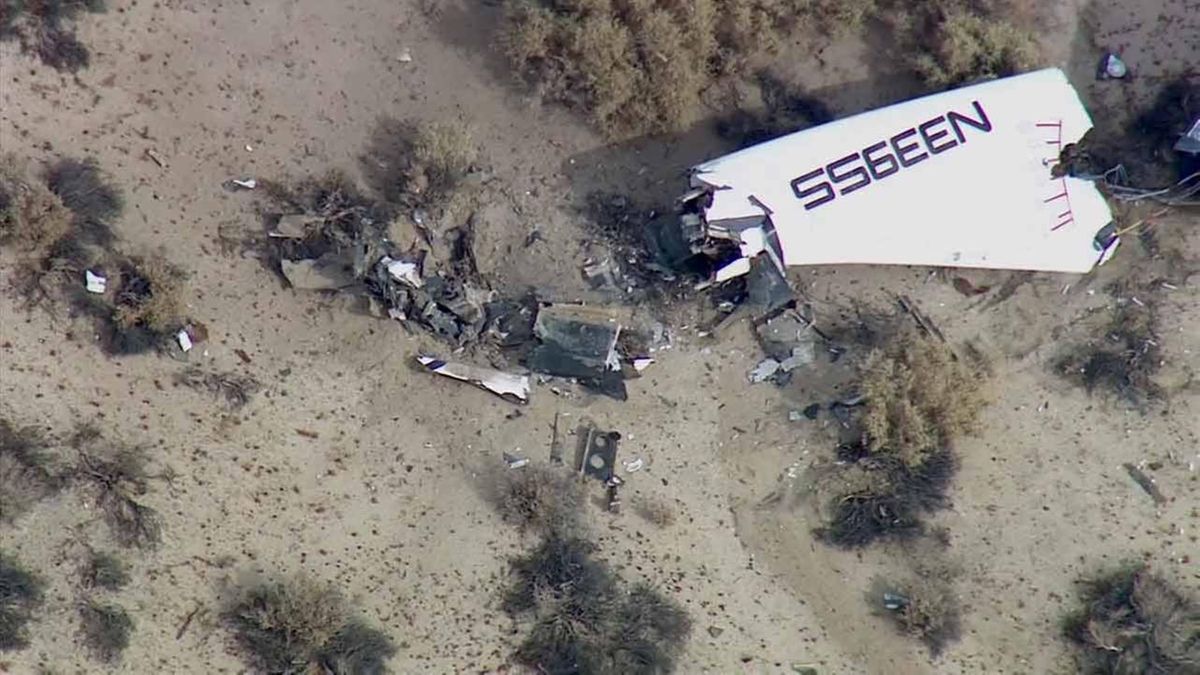SpaceShipTwo crash in Mojave kills one test pilot, leaves second pilot injured
Design came out of firm launched by Burt Rutan

MOJAVE, Calif. (AP) — A Virgin Galactic space tourism rocket exploded Friday during a test flight, killing a pilot aboard and seriously injuring another while scattering wreckage in Southern California’s Mojave Desert, witnesses and officials said.
The company founded by British billionaire Richard Branson would not say what happened other than that it was working with authorities to determine the cause of the “accident.”
“During the test, the vehicle suffered a serious anomaly resulting in the loss of SpaceShipTwo,” Virgin Galactic tweeted.
Ken Brown, a photographer who witnessed the crash, told The Associated Press that SpaceShipTwo exploded after a plane designed to take it to high altitude released it and the craft ignited its rocket motor.
Brown said the wreckage fell in the desert north of Mojave Air and Space Port, where the test flight originated. The area is about 120 miles north of downtown Los Angeles.
SpaceShipTwo, which is typically flown by two pilots, was designed to provide a suborbital thrill ride into space before it returns to Earth as a glider.
SpaceShipTwo is based on aerospace design maverick Burt Rutan’s award-winning SpaceShipOne prototype, which became the first privately financed manned rocket to reach space in 2004. Rutan’s California aerospace firm, Scaled Composites, built SpaceShipOne.
Rutan, who now lives in Coeur d’Alene, left Scaled Composites before the larger SpaceShipTwo was designed and built.
Friday’s flight marked the 55th for the spaceship, which was intended to be the first of a line of craft that would open space to paying civilians. At 60 feet long, SpaceShipTwo features two large windows for each of up to six passengers, one on the side and one overhead.
Virgin Galactic — owned by Branson’s Virgin Group and Aabar Investments PJS of Abu Dhabi — sells seats on each prospective journey for $250,000, with full payment due at the time of booking. The company says that “future astronauts,” as it calls customers, have visited Branson’s Caribbean home, Necker Island, and gone through G-force training.
Stephen Hawking, Justin Bieber, Ashton Kutcher and Russell Brand are among the celebrities to sign up for flights. Virgin Galactic reports taking deposits totaling more than $80 million from about 700 people.
A related venture, The Spaceship Co., is responsible for building Virgin Galactic’s space vehicles.
During testing for the development of a rocket motor for SpaceShipTwo in July 2007, an explosion at the Mojave spaceport killed three workers and critically injured three others. A California Division of Occupational Safety and Health report said the blast occurred three seconds after the start of a cold-flow test of nitrous oxide — commonly known as laughing gas — which is used in the propulsion system of SpaceShipTwo. The engine was not firing during that test.
Friday’s accident was the second space-related explosion this week.
On Tuesday, an unmanned commercial supply rocket bound for the International Space Station exploded moments after liftoff from a launch site in Virginia. No injuries were reported that accident, which drew criticism over NASA’s growing reliance on private U.S. companies in this post-shuttle era
Virgin Galactic planned to launch space tourism flights from the quarter-billion-dollar Spaceport America in southern New Mexico once it finishes developing its rocket ship.
Christine Anderson, executive director of the New Mexico Spaceport Authority, did not want to comment on the events unfolding Friday in the California desert or what effect they might have on Spaceport America and the future of commercial space travel.
Virgin Galactic is in line to be the main tenant at the spaceport that was built specifically to launch paying customers into space, a dream of Branson’s. His company has repeated pushed back the timetable for when the $250,000 flights were to begin, pointing to delays in development and testing of the rocket ship.
Taxpayers footed the bill to build the state-of-the-art hangar and runway in a remote stretch of desert in southern New Mexico as part of a plan devised by Branson and former New Mexico Gov. Bill Richardson. Critics have long challenged the state’s investment, questioning whether flights would ever get off the ground.
Commercial development has been slower than expected. When Virgin Group licensed the technology from Microsoft co-founder Paul Allen, who funded about $26 million for SpaceShipOne, Branson envisioned operating flights by 2007.